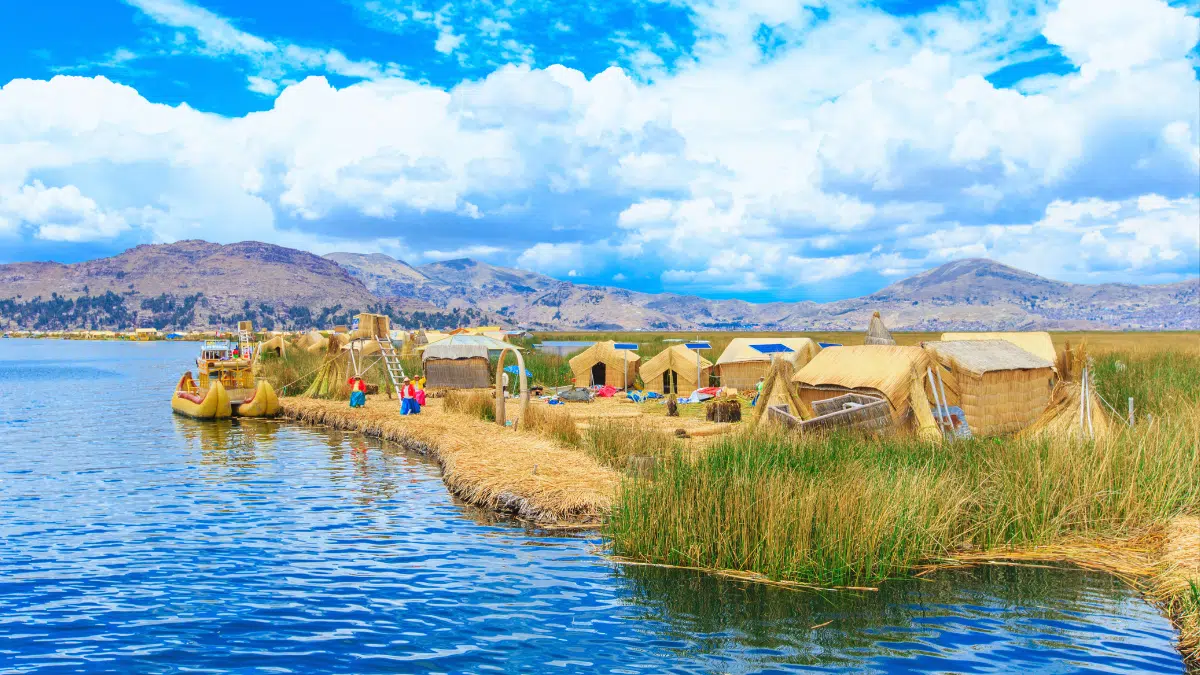Lake Titicaca | How To Visit From Peru and Bolivia [2024 Guide]
Nestled among the impossibly high Andes Mountains between Peru and Bolivia, Lake Titicaca is among the most mythical, if little-understood landmarks in South America. With stunning natural beauty and a rich history extending back long before the Incan Empire arose from nearby Cusco, the world’s highest navigable lake is a destination that will take your breath away.
Planning your own visit to magical Lake Titicaca? This ultimate travel guide to the island includes our tried-and-tested tips for experiencing Lake Titicaca firsthand, whether your visit includes either the Peruvian or Bolivian sides of the lake.
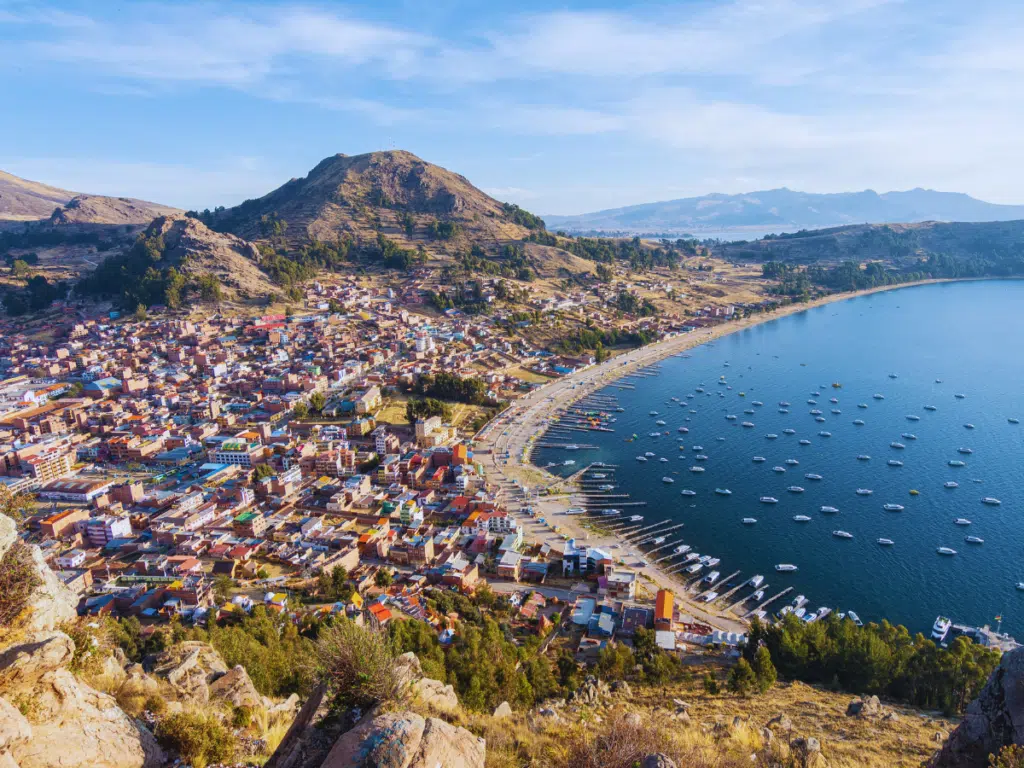
This post contains affiliate links that may reward me monetarily or otherwise when you use them to make qualifying purchases – at no cost to you. As an Amazon Associate, I earn from qualifying purchases. For more information, please read our disclosure policy.
Lake Titicaca
Fed by glacial waters and dozens of rivers, Lake Titicaca is a natural jewel among the impossibly high-altitude Andes Mountains of South America. Deep, ancient waters rimmed by soaring mountains make it a stunning spot – with plenty to see and do.
A rich tapestry of history makes this corner of Peru and Bolivia one of the most culturally rich destinations in South America. Festivals, homestay experiences, tours of archeological sites and museums, and traditional handicrafts are just a handful of the ways visitors can experience it all firsthand.
Lake Titicaca was home to civilizations such as the Pukara, Tiwanaku, and Qollas – and that was before the Incas even existed. Bolivia’s Isla del Sol at the heart of the lake is considered the birthplace of the Incan Empire, with legend holding that the first Incan emperor, Manco Capac, and his wife Mama Ocllo, were sent to Earth by the sun god at this very spot.
Cruising the lake and visiting the floating Uros Islands – constructed of reeds and still the permanent homes of thousands of indigenous Uros people – is just one of the highlights. Visiting nearby archeological sites, staying in eco-lodges, or spending the night at a guesthouse with a local family are all among some of the best things to do in Peru and Bolivia.
While Lake Titicaca is remote, it’s within day-trip distance of major cities in South America like La Paz, Bolivia, and even Cusco, Peru. If you haven’t considered adding Lake Titicaca to your South America itinerary yet, now is the time!
Where Is Lake Titicaca Located?
Lake Titicaca is located along the Peru-Bolivia border in a high-altitude area of the Andes mountains known as the Altiplano (High Plateau). This massive lake covers 3,200 square miles (8,300 square km) and is nearly equally on both the Peruvian and Bolivian sides of the border.
While there are dozens of towns and villages that surround Lake Titicaca, the most well-known destinations for visitors looking to experience the lake include Puno on the Peruvian side of the lake and Copacabana on the Bolivian side of the lake. Most visitors will experience the lake from one of both of these cities.
Why Is Lake Titicaca Famous?
Lake Titicaca is a UNESCO World Heritage Site famous for more than just being the world’s highest navigable lake. It’s also one of less than two dozen “ancient lakes” on Earth, considered to have existed for over a million years; scientists estimate that Lake Titicaca has existed for about three million years.
Lake Titicaca is also famous for its unique floating islands, long a part of the lifestyles of residents of the lake. Known as the Uros Islands, these floating islands are made from reeds that grow around the lake and are the permanent home to around 1,200+ indigenous Uros people.
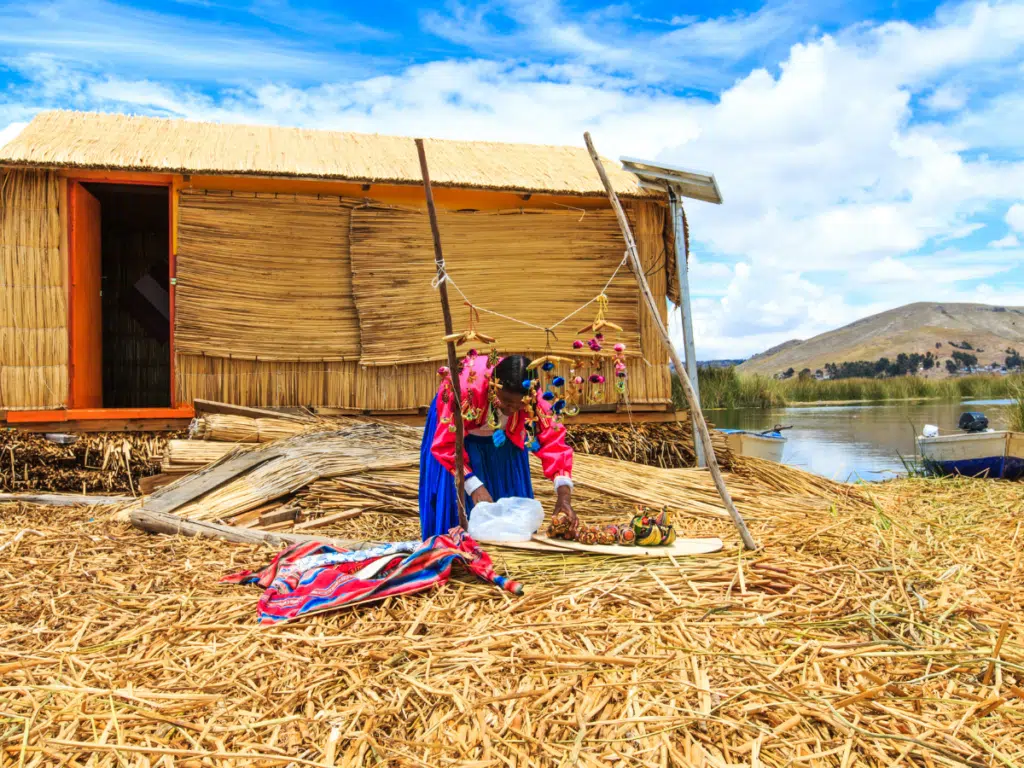
Lake Titicaca Floating Islands
The History of the Floating Islands
One of the most famous features of Lake Titicaca is its floating islands. These floating islands, known as Uros islands, are created by locals using totora reeds, which grow in Lake Titicaca. These islands have long been created by the indigenous Uros (or Uru) peoples that have called them home for centuries.
Floating islands in Lake Titicaca were originally created by the Uros peoples to protect them from the growing threat of the Incan empire. If trouble appeared on the horizon, they could simply unanchor the islands and move them temporarily to more inaccessible parts of the lake.
Uros Islands Today
Today, up to 1,200 people still live on the floating islands, which are located closer to the Peruvian side of Lake Titicaca, approximately a 30-minute boat ride from Puno. Curious travelers can visit the islands to experience them firsthand or even spend the night with a local family on the islands. Most day trips depart from Puno, with tours from Copacabana usually involving driving to Puno first.
Lake Titicaca’s Other Islands
In addition to Lake Titicaca’s floating islands, there are a number of regular islands in the middle of the lake. Not as famous as the Uros Islands, they’re still incredibly beautiful destinations and tend to be some of the most popular destinations for day trips from Puno and Copacabana.
- Isla del Sol: This island on the Bolivian side of the lake is where legend holds that the Incan Empire got its start. Numerous ruins make it a popular destination for visitors.
- Isla de la Luna: This tiny island on the Bolivian side of the lake also has some important Incan ruins worth exploring.
- Taquile Island: On the Peruvian side of the lake, Taquile Island is known for its weaving and handicraft traditions and has a permanent population of over 2000 people.
- Amantani Island: On the Peruvian side of the lake, Amantani Island is home to about 800 families and is infrequently visited other than for travelers looking for an overnight with locals, which is one of the best things to do at Lake Titicaca!
Best Uros Islands Excursions
Things To Do at Lake Titicaca
1. Get Out on the Lake
For as much as the shores of Lake Titicaca have much to offer, there’s nothing better than getting out on the lake. Take a scenic cruise on the lake, or even better, experience the lake as part of a guided excursion to destinations like the floating Uros Islands, Taquile Island in Peru, or Isla del Sol in Bolivia.
If you’re looking for other unique ways to explore Lake Titicaca, consider renting kayaking to explore. Just be careful not to tip over! While you can technically swim in Lake Titicaca, you wouldn’t want to – the high elevation here means the water is frigidly cold.
2. Visit the Floating Uros Islands
The number one place to visit at Lake Titicaca is the unique floating Uros Islands. Excursions to the islands usually include a guided tour of the communities that live there that covers their history and how they were created – it’s even more fascinating than you’d expect!
The Uros Islands are found on the Peruvian side of the lake, relatively close to Puno, Peru. Almost every day trip on Lake Titicaca includes visits to the islands. We recommend booking in advance with a reputable company with English-speaking guides (here’s the tour we chose and recommend highly!), but you can also find last-minute excursions to the islands if you make your way down to the main dock in Puno.
3. Spend a Night On the Islands
Lakeside accommodations in Puno, Peru and Copacabana, Bolivia can be both comfortable and affordable, but for an even better way to stay at Lake Titicaca, head to one of the islands. Isla del Sol in Bolivia and Taquile Island in Peru are some of the most popular spots for island overnights, though you can even find accommodations on the floating Uros Islands.
These are our top recommendations for island stays in Lake Titicaca:
- Puma Punku Ecolodge – Isla del Sol, Bolivia
- Wiñay Inti Lodge – Isla del Sol, Bolivia
- Taquile Lodge – Taquile Island, Peru
- Uros Titicaca Lodge – Uros Islands, Peru
If you’re looking for an unforgettable accommodation experience at Lake Titicaca, there’s nothing better than staying on one of the lake’s islands with a local family. Share traditional meals and experience indigenous culture firsthand – it’s a truly memorable experience.
Reviews and Bookings: Overnight Homestay Experience on Lake Titicaca
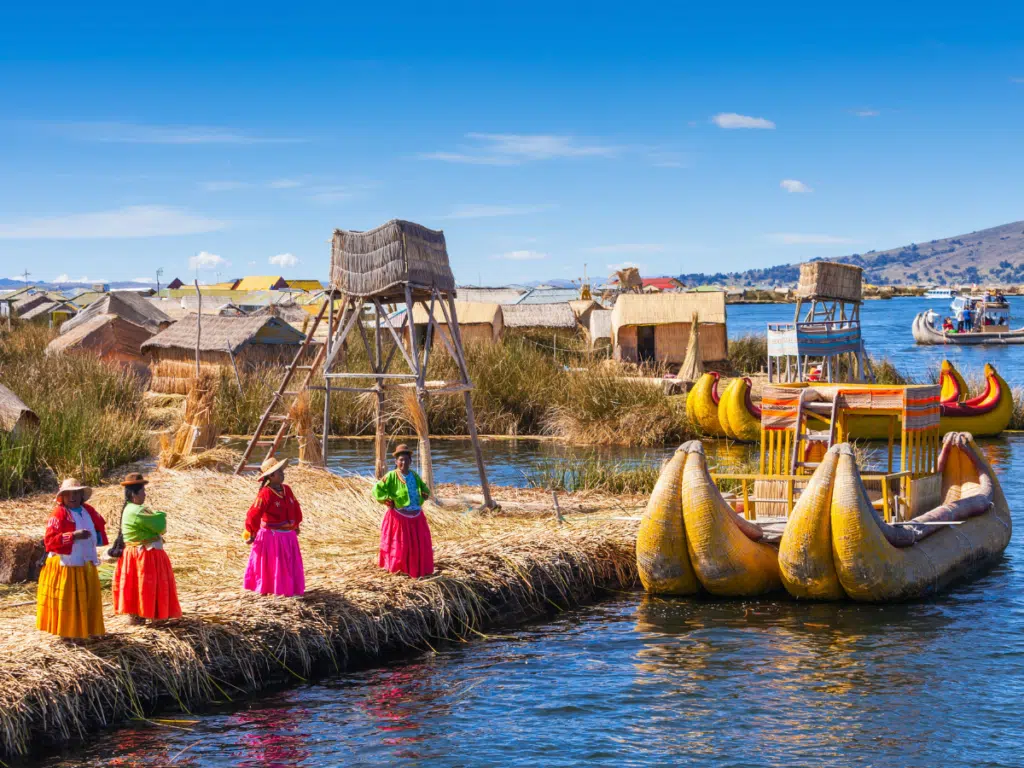
Visiting Lake Titicaca – From Peru or Bolivia?
Travelers planning a trip to Lake Titicaca want to know: should I visit Lake Titicaca from Peru or Bolivia? Often, the answer comes down to the other destinations you’ll be visiting on your trip; if you’re also visiting Machu Picchu, you’ll definitely want to visit Lake Titicaca from Peru!
These are some of the highlights on both sides of the border.
- Lake Titicaca in Peru has the floating Uros Islands and Taquile Island, known for the incredible weaving and textile traditions of its indigenous populations. Large but vibrant Puno has everything you’d want and plenty of places to eat and stay, as well as generally more luxurious accommodations.
- Lake Titicaca in Bolivia has the vibrant city of Copacabana and endless ancient archeological sites; especially noteworthy are those on Isla del Sol. With the snow-capped mountains of the Cordillera Real in the distance, it’s widely thought to be the more beautiful side of the lake.
If you can, planning to visit both sides of Lake Titicaca is the best way to experience this destination. You won’t want to miss the floating Uros Islands off the coast of Puno or the archeological sites on Isla del Sol and the stunning vistas overlooking Copacabana, Bolivia. By spending at least three days here, you’ll be able to do it all – on both sides of the lake.
Crossing the Peru-Bolivia Border at Lake Titicaca
For most travelers, crossing the Peru-Bolviia border is a relatively simple process. A bus or car will take you to the border, generally at the border crossing at Yunguyo, which offers access to Copacabana and Isla del Sol in Bolivia from Puno, Peru.
You’ll approach immigration officers and the border crossing and be stamped out of one country before being stamped into another. Allow time for unexpected lines or bureaucracy, but it’s generally an uncomplicated process.
The relatively easy, straightforward border crossing process makes it easy for travelers to experience both sides of Lake Titicaca in one trip. Of course, it’s always best to check the visa requirements for travelers of your country of origin before planning on crossing the border.
A note for travelers from the United States: American citizens used to be required to apply for a visa to Bolivia before visiting the country, providing ample paperwork that most travelers don’t carry with them. This is no longer the case, though there are several websites out there that have yet to update this information. It’s now just as easy for an American to visit Bolivia as almost anywhere else.
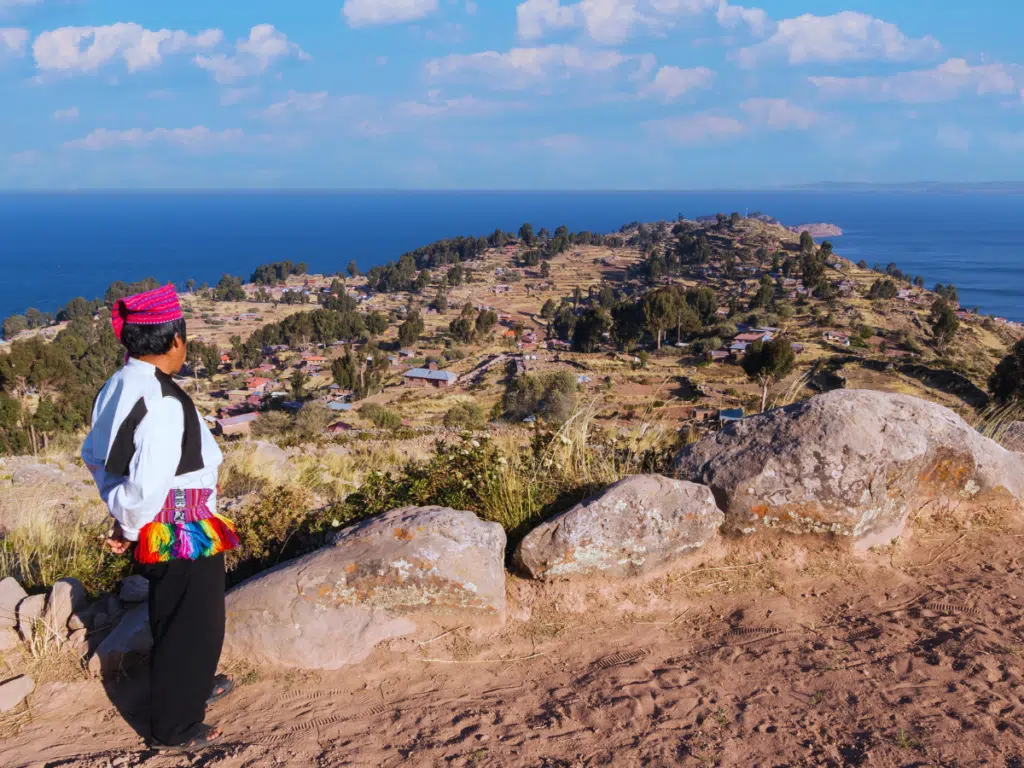
Lake Titicaca Peru
For the majority of visitors to Lake Titicaca, the journey begins on the Peruvian side of the border. Visiting Lake Titicaca is among the best things to do in Peru, and is one of the country’s top attractions for visitors.
Lake Titicaca’s relative proximity to Cusco, the undisputed must-visit destination in the country as the gateway to Machu Picchu, is one of the reasons it is so popular. Granted, the journey is long – it’s about a 6.5-hour drive between Cusco and Puno, and there are no direct flights between the cities. However, it makes for a great addition for two or three days to any classic Peru itinerary.
The Peruvian side of the lake is best known as home to the floating Uros Islands; visiting the islands is a must for any visitor, and they’re easily accessible via frequent and affordable boats from Puno. The Peruvian side of the lake is also home to the gorgeous Taquile Island and the city of Puno.
Puno, Peru
The largest city on Lake Titicaca – on either side of the border – is Puno, Peru. Most travelers tend to prefer other cities in Peru over Puno, especially more charming destinations like Cusco and Arequipa, but as a gateway to Lake Titicaca, Puno can’t be beaten.
Some of the best things to do in Puno, other than getting out on Lake Titicaca, include touring the historic parts of the city like Puno’s 18th-century cathedral, and heading up to the statue of Manoc Capac, the first Incan leader, who stands watch over the city from a hilltop with gorgeous views.
Nearby destinations in Puno also worth a visit include the archeological sites of Sillustani and Chucuito, which are important remanents of the Qolla and Inca civilizations, respectively.
A wider variety of accommodations in Puno (as opposed to Copacabana, Bolivia) and more conveniences tend to make Puno the preferred destination of choice from which to experience a stay on the lake.
Where To Stay in Puno, Peru
- Kantaya Hostel ($)
- Tierra Viva Puno Plaza ($ – $$)
- Uros Titicaca Lodge ($$ – $$$)
Taquile Island
Taquile Island is another one of the most popular destinations for visitors to Lake Titicaca looking to explore the Peruvian side of the lake. Located about 27 miles (45 kilometers) off the coast of Puno, this small island is home to around 2,000 permanent Quechua-speaking residents.
This island is primarily known for the masterful weaving and textile traditions of its residents, who boast what is considered to be the most masterful craft in all of Peru. Make sure to visit the handicraft market to purchase some of these wares for yourself before heading to the Mulsina Pata viewing point at the highest point on the island, also home to impressive archeological ruins.
Reaching Taquile Island is quite a journey – it’s about 3.5 hours by boat each way! – but visits often include stop-offs at the floating Uros Islands along the way.
Best Lake Titicaca Experiences in Puno, Peru
Getting to Lake Titicaca from Peru
Almost all travelers access Lake Titicaca from Peru via the city of Puno, which is located directly on the lake. From Puno, travelers who haven’t pre-booked activities in town can easily find excursions on the lake or in the area at tour provider offices or by heading down to the lakefront.
As one of the more important cities in Peru, Puno is well-connected to other cities in Peru via bus. The nearest airport to Puno is the Inca Manco Cápac International Airport in Juliaca, just a few miles down the road from Puno.
Lake Titicaca From Cusco
While Lake Titicaca is about a 6.5-hour journey from the Sacred Valley, Cusco remains an important gateway to the lake for many travelers. Unfortunately, there are currently no direct flights from Cusco to Puno (Juliaca), so if you want to fly to Lake Titicaca, you’ll need to connect via Lima.
You’ll find numerous excursions to Lake Titicaca that depart from Cusco, most including at least one overnight in Puno or on one of the lake’s floating islands for the full experience. Alternatively, budget-conscious travelers can take public transportation or book private transportation but take care of experiences and accommodations once they arrive at the lake.
Best Lake Titicaca Experiences From Cusco, Peru
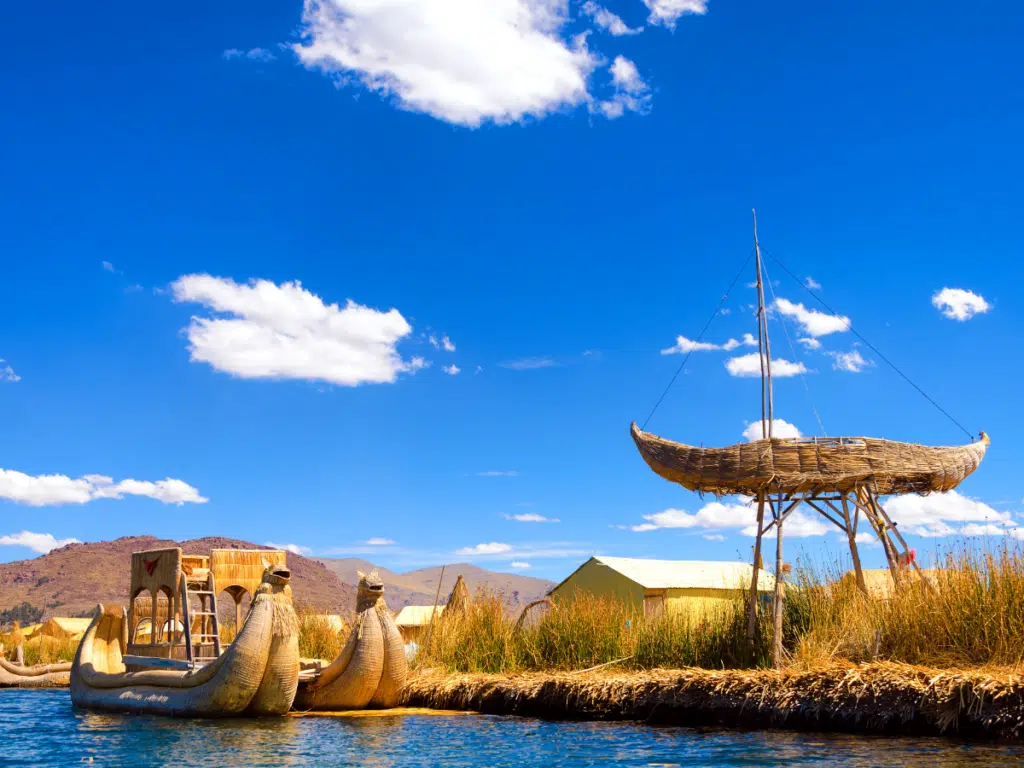
Lake Titicaca Bolivia
Whether your trip to Lake Titicaca includes time in Peru or Bolivia – or both! – you’re bound to have a great time. However, the Bolivian side of Lake Titicaca is generally considered to be more beautiful, with snow-capped Cordillera Real mountains making for a dramatic backdrop near the lake’s most important historical sites.
Just 45 miles west of La Paz, Lake Titicaca is easily accessible from this major South American capital, either as a day trip or as the first stop on a longer journey. Nearby ruins like those at Tiwanaku and plenty of things to do in La Paz and beyond make the Bolivian side of the border a tempting addition to a travel itinerary.
While the Peruvian side of the lake is the gateway to the must-visit floating islands, Bolivia is home to the lake’s most important “stationary” islands, including Isla del Sol, which is considered the birthplace of the Incan empire.
Copacabana, Bolivia
Copacabana is the largest city on the Bolivian side of Lake Titicaca, making it a must-visit destination when exploring the lake, whether as a day trip from La Paz or as part of a longer stay. While there isn’t much to do here, it’s a convenient and impressive gateway to the best of the Bolivian side of Lake Titicaca.
Copacabana revolves around life on the lake, with plenty of tour operators and accommodation options catering to visitors. A beautiful central plaza with the stark white Basilica of Our Lady of Copacabana adds charm to this relatively small town.
Make sure to climb to the top of Cerro El Calvario for the most impressive view of the large, arching waterfront of Copacabana and Lake Titicaca from above.
Where To Stay in Copacabana, Bolivia
- Hostal La Cúpula ($)
- Hostal Las Olas ($ – $$)
- Hotel Rosario Lago Titicaca ($$)
Isla del Sol + Isla de la Luna
Two of the most popular destinations for visitors on the Bolivian side of Lake Titicaca are the Isla del Sol (Island of the Sun) and Isla de la Luna (Island of the Moon). Scattered across these islands are hundreds of ancient ruins and historical sites, making them fascinating destinations you won’t want to miss.
Larger Isla del Sol is home to several villages and is a popular spot for visitors to spend the night with local families. Its most famous ruins are Pilko Kaina and Chincana.
Best Lake Titicaca Experiences in Bolivia
Getting to Lake Titicaca from Bolivia
Lake Titicaca is one of the most important destinations for travelers headed to Bolivia. You’ll have no problem finding a way to reach Lake Titicaca, no matter where your Bolivia itinerary takes you.
Lake Titicaca’s proximity to the Bolivian capital of La Paz (about two hours!) means that nearly all travelers visit Lake Titicaca from La Paz. Organized day trips from La Paz are generally the most popular way to travel, though it’s quite easy and affordable to catch one of the many public buses that connect these two destinations.
Lake Titicaca From La Paz
By Bus
Frequent buses (four to five a day) depart from the central La Paz bus terminal, providing the most affordable way to travel between Lake Titicaca and La Paz. No need to worry – the bus won’t fly down Bolivia’s famous Death Road, though excursions to the Death Road are some of the most popular day trips from La Paz.
However, taking the bus will add time to the experience; the bus tends to take around 4 hours, while a drive takes around 2 hours. If you’re planning on using the bus to reach the lake, you’ll definitely want to spend at least one night at Lake Titicaca.
By Excursion
We almost universally recommend choosing from among the affordable day trips from La Paz to Lake Titicaca for how they save travelers hours of travel time. Taking an organized day trip makes a true day trip from La Paz possible and eliminates the hassle of navigating public transport. They’re also inclusive of activities at the lake, meaning you’ll be able to enjoy your time even more.
Tiwanaku and Lake Titicaca
Many day trips from La Paz also include a stop at Tiwanaku, one of the most important and significant spots in Bolivia for its pre-Columbian ruins. Tiwanaku was the impressive capital of the empire of the Tiwanaku people, making it one of the most important ruins in South America that aren’t of Incan origin.
Looking for a trip to both Lake Titicaca and Tiwanaku? We recommend this full-day trip from La Paz to Lake Titicaca and Tiwanaku.

Lago Titicaca
With so many superlatives to its name, Lake Titicaca is a destination that is guaranteed to surprise and impress you at every turn.
Spend a memorable visit getting close to age-old cultures by exploring pre-Columbian ruins, spending time connecting with locals, or stepping gingerly across floating islands. Whether you’re planning your trip from the lake’s Peruvian side or its Bolivian side is the least of your concerns when the best of Lake Titicaca awaits.

Carley Rojas Avila is a bilingual New York-based travel writer, editor, content marketer, and the founder of the digital travel publications Explorers Away and Home to Havana. Carley is an expert on all things Latin America, the Caribbean, and Cuba, having lived and worked in four different countries in the region. Her writing has appeared on the Associated Press wires and in Travel + Leisure, Yahoo, MSN, Euronews, The Weather Channel, and more. When she's not writing about her travels, find her front row at a Bad Bunny concert, befriending street cats, and taste-testing every pizza in Havana.

